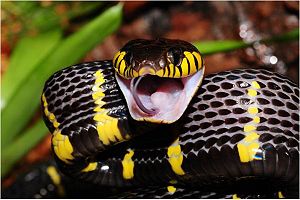Sandbox Reserved 932
From Proteopedia
| Line 22: | Line 22: | ||
=== Denmotoxin belongs to a family of non-conventional three-finger toxins === | === Denmotoxin belongs to a family of non-conventional three-finger toxins === | ||
| + | |||
Three-finger toxins (3FTXs) are the most common family of snake venom proteins; these venoms can be found in elapid, colubrid and hydrophiid snakes and include toxins such as α-cobratoxin and α-bungarotoxin. 3FTXs are non-enzymatic proteins which form a structurally conserved superfamily whose members all share a highly conserved structure. The core structure of 3FTXs is formed by three <scene name='57/579702/Three_fingers/1'>three β-stranded polypeptide loops</scene> joined together by four conserved disulphide bridges located in the <scene name='57/579702/3ftx_beta_strands/2'>core</scene> of the protein. Despite the similarities in the structure of different toxins belonging to the family, the 3FTXs from various venoms have a variety of receptors/acceptors and exhibit differential responses in their targets. The members of the family can vary slightly in: the length and type of twists of the tree loops; the length and type of turns of the N and C-terminal tail and the amount of β-sheets in the overall structure. These differences allow for the specificity and toxicity of the proteins to their targets. | Three-finger toxins (3FTXs) are the most common family of snake venom proteins; these venoms can be found in elapid, colubrid and hydrophiid snakes and include toxins such as α-cobratoxin and α-bungarotoxin. 3FTXs are non-enzymatic proteins which form a structurally conserved superfamily whose members all share a highly conserved structure. The core structure of 3FTXs is formed by three <scene name='57/579702/Three_fingers/1'>three β-stranded polypeptide loops</scene> joined together by four conserved disulphide bridges located in the <scene name='57/579702/3ftx_beta_strands/2'>core</scene> of the protein. Despite the similarities in the structure of different toxins belonging to the family, the 3FTXs from various venoms have a variety of receptors/acceptors and exhibit differential responses in their targets. The members of the family can vary slightly in: the length and type of twists of the tree loops; the length and type of turns of the N and C-terminal tail and the amount of β-sheets in the overall structure. These differences allow for the specificity and toxicity of the proteins to their targets. | ||
| Line 41: | Line 42: | ||
=== Interaction model with nicotinic acetylcholine receptor === | === Interaction model with nicotinic acetylcholine receptor === | ||
| + | |||
[[Image:Bungarotoxin interaction with nACHr figure text.png|300px|right|thumb| Suggested interaction of '''α-bungarotoxin''' in binding pocket of nAChR (simplified figure) [PDB=4HQP]]] | [[Image:Bungarotoxin interaction with nACHr figure text.png|300px|right|thumb| Suggested interaction of '''α-bungarotoxin''' in binding pocket of nAChR (simplified figure) [PDB=4HQP]]] | ||
Revision as of 09:13, 18 May 2014
| This Sandbox is Reserved from 01/04/2014, through 30/06/2014 for use in the course "510042. Protein structure, function and folding" taught by Prof Adrian Goldman, Tommi Kajander, Taru Meri, Konstantin Kogan and Juho Kellosalo at the University of Helsinki. This reservation includes Sandbox Reserved 923 through Sandbox Reserved 947. |
To get started:
More help: Help:Editing |
B. Dendrophila monomeric toxin (Denmotoxin) is the primary protein of snake venom used by Boiga dendrophila. This colubrid snake lives in Southest Asian lowland rainforest and mangrove swamps using birds as its primary prey.
One of the most well characterized snake venom protein families is the Three-finger-toxins (3FTX). These proteins consist of three β-stranded finger-like polypeptide loops stabilized by four disulphide bridges on the surface of a globular core. In non-convential 3TFXs a fifth disulphide bridge can be present as is the case in Denmotoxin. The crystal structure of denmotoxin was solved to 1.9Å by molecular replacement method.
Denmotoxin binds specifically to bird muscle nicotinic acetylcholine receptors preventing their normal function in signal transduction. This taxon specifity is reached by unique structural differences to other 3FTXs such as changes in the suggested binding loop of the protein.
Denmotoxin
| |||||||||||
Additional Information
References
Pawlak, J.; Mackessy, S.; Fry, B.; Bhatia, M.; Mourier, G.; Fruchart-Gaillard, C.; Servent, D.; Ménez, R.; Stura, E.; Ménez, A. 2006. Denmotoxin, a Three-finger Toxin from the Colubrid Snake Boiga dendrophila (Mangrove Catsnake) with Bird-specific Activity. The Journal of Biological Chemistry: 281: 29030-29041 doi: 10.1074/jbc.M605850200

![Three fingers formed by three peptide loops (F1, F2 & F3) [PDB=2H5F]](/wiki/images/thumb/3/3f/Kolme_sormea_figure_text.png/300px-Kolme_sormea_figure_text.png)
![Suggested interaction of α-bungarotoxin in binding pocket of nAChR (simplified figure) [PDB=4HQP]](/wiki/images/thumb/d/d7/Bungarotoxin_interaction_with_nACHr_figure_text.png/300px-Bungarotoxin_interaction_with_nACHr_figure_text.png)
